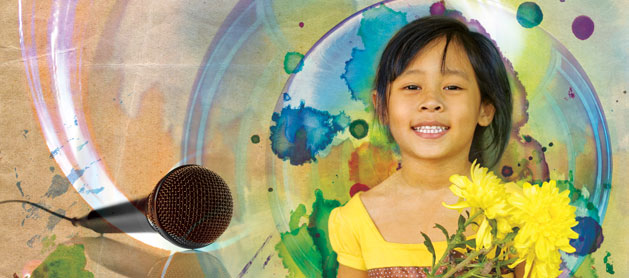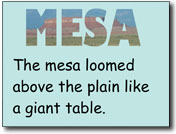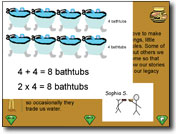
Reinterpret software’s role in ELL classrooms

English Language Learners (ELLs) are the fastest growing group of students in American schools today (Payàn & Nettles, 2008). Research shows that these students must make language gains of almost two years per academic year to catch up with native English learners. Producing meaningful, language-rich projects to demonstrate academic concepts and improve fluency levels can engage your ELL students and improve their English language skills.
Creative software tools provide multiple opportunities for engaging ELL students in both language and core content acquisition through original artwork, cross-curricular and cross-cultural clip art, integrated photo galleries, activity files, listening and speaking tools, and multiple methods for sharing finished work.
Tools like Wixie allow students to combine text, original artwork, clip art, and voice narration to produce meaningful work and demonstrate understanding. Wixie affords ELL students with the opportunity to provide both verbal and nonverbal responses to indicate comprehension (Guhlin, 2002). This is especially important when students are still in their silent period of language acquisition, when affective filters are at their strongest.
Creative multimedia tools allow all students to be tasked with the same assignment while providing a variety of tools to match each learner’s language acquisition stage. For example, students in the preproduction stage can use paint tools to draw pictures or add stickers to visually represent ideas and understanding, while students in the early production and speech-emergence stage can layer written work and spoken language into a project using text objects and sound recording features. In both cases, student work can be evaluated for content understanding.
Using non-verbal and non-linguistic forms of communication can strengthen understanding for ELLs and native English speakers alike. Many activities, like the pre-algebra skill of patterning, can be done using only pictures. Other activities, such as visual multiplication problems, utilize pictures as a way to build comprehension and understanding of mathematical processes.

Students can use recording features to narrate text on a page or explain the scenarios they create, giving learners an important opportunity to practice their speech and perfect their pronunciation (Egbert, 2002). Because students can record, listen, and re-record as many times as they like, ELL students at all levels have a private, non-threatening opportunity to practice fluency (Krashen, 1985).
Projects that includes images, text, and recorded narration provide a performance teachers can use to assess both reading and writing fluency. Such projects also demonstrate to teachers, parents, and students how their fluency progresses throughout the year.
Systematic vocabulary development is essential to second language acquisition, since students do not learn enough vocabulary merely by listening or naturally encountering words in the world around them (Nation, 1990). Increasing a learner’s vocabulary leads to improved reading comprehension, benefitting performance in all subject areas.
Effective vocabulary instruction must include structured opportunities to use words in a meaningful context (Kinsella, 2005). While constructing definitions for new words is a start, it should be supported with examples, analogies, synonyms, and analyses.
Non-linguistic representations provide an avenue of success for English Language Learners. Drawing pictures of a word’s meaning helps students communicate understanding –and helps teachers identify misunderstandings – even if they do not yet have the vocabulary to produce synonyms or antonyms. The visual representation of the word also serves to better encode the word into the mind of the student.
Tech4Learning's Pixie includes a Cool Word feature which allows students to use a picture to illustrate a word. Creating Cool Word vocabulary projects requires students to identify an image that represents the definition of the word they are learning. When students create a Cool Word image, type the definition of a term in a text object, and record a vocal explanation of the term, they involve three important cueing systems (text, images, and narration) that help facilitate retention and retrieval of the meaning of the word or concept.

Increasing students’ subject matter understanding and competency are the goals of instruction; students’ attention, effort, and engagement in the task at hand is the key to achieving those goals (Beck, 2000). Having students produce meaningful projects they can share with others is tremendously motivating and leads to additional risk-taking essential to additional language gains.
Products targeted for second language learners often focus on students learning from the computer by listening or repeating. To truly grasp a second language, students must spend a significant amount of their time producing authentic language. Krashen suggests that acquisition is, “an unconscious process when language is used for real communication purposes.”
Creating comic books, trading cards, podcasts, and electronic stories, allows language learners to communicate in mediums they see in the world beyond the classroom. Combining these powerful publishing options with activities designed to strengthen academic and language acquisition provides opportunities for authentic work.
Having students work collaboratively can also greatly contribute to a successful ELL classroom. Working cooperatively with native English speakers or other English learners increases students’ opportunities to hear and produce English and to negotiate meaning with others (Cohen et al., 1990). Students can build classroom newsletters, podcasts, reports, and classroom stories, providing opportunities to produce authentic language products with the support of their classmates.
Students can create individual pages that can be combined into a class project or collaborate in real time to develop a shared page or project. Partner strong English speakers and writers who can add text and record narration with early-stage learners who can support the text and speech with clip art and illustrations.

Creativity tools appeal to a wide range of learners, but there is an ever-growing body of resources for using tools like Wixie for language learning. Teachers can use activity templates that focus on learning parts of speech and other important grammatical structures to assess individual progress or as a basis for whole-group activities using an interactive whiteboard.
Graphic organizer templates support student comprehension as they use them to explore historical events, scientific processes, or passages of text. Using such non-linguistic representations helps students organize and elaborate on their thinking and writing, improving comprehension (Marzano, 2001).
Creative multimedia tools provide all students, especially second language learners a platform to take risks, be creative, and demonstrate their unique learning styles, interests, and abilities in an authentic fashion. All students need to learn to produce information instead of merely consuming content. Only when we harness the power of open-ended creativity tools will we truly know what the fastest-growing segment of our school population can produce!
Krashen, S. (1985). The Input Hypothesis: Issues and Implications. New York: Longman.
Marzano, R. J., Pickering, D. J., & Pollock, J. E. (2001). Classroom Instruction that Works: Research-Based Strategies for Increasing Student Achievement. Alexandria, VA: ASCD.
Nation, I.S.P. (1990). Teaching and Learning Vocabulary. New York: Newbury House.
Payàn, R. M., & Nettles, M. T. (2008). Current State of English-language learners in the U.S. K–12 Student Population (English-Language Learners Symposium Fact Sheet). Princeton, NJ: Educational Testing Service.
Cohen, E., Lotan, R., & Catanzarite, L. (1990). Treating Status Problems in the Cooperative Classroom. In S. Sharon (Ed.) Cooperative learning: theory and research (pp. 203-229). New York: Praeger.
Egbert, J (2002) A Project for Everyone: English Language Learners and Technology in Content-Area Classrooms. Learning and Teaching with Technology, 36-41.
Gughlin, M. (2002). Bilingual Education and Technology. TechEdge, 26-27.
Kinsella, K. (2005) Teaching Academic Vocabulary, an Aiming High Resource. Sonoma: Sonoma County Office of Education.

Follow us on Instagram for daily inspiration

Create a thought web, cluster, flowchart, or other graphic organizer for a lesson
Five ideas for creative classroom centers
Creative, digital book reviews
Fun and powerful ideas with animated characters

Wixie
Share your ideas, imagination, and understanding through writing, art, voice, and video.

Rubric Maker
Create custom rubrics for your classroom.

Pics4Learning
A curated, copyright-friendly image library that is safe and free for education.

Wriddle
Write, record, and illustrate a sentence.

Get creative classroom ideas delivered straight to your inbox once a month.
Topics